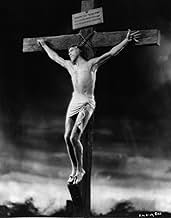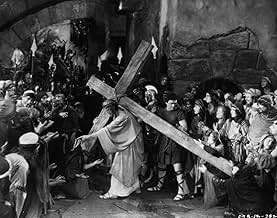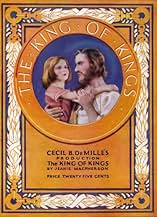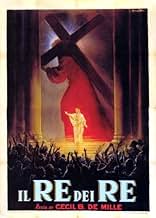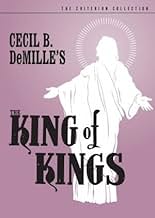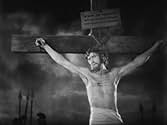CALIFICACIÓN DE IMDb
7.3/10
2.6 k
TU CALIFICACIÓN
Jesucristo se enfrenta a la opresión religiosa y política durante su ministerio y en los días previos a su muerte y resurrección.Jesucristo se enfrenta a la opresión religiosa y política durante su ministerio y en los días previos a su muerte y resurrección.Jesucristo se enfrenta a la opresión religiosa y política durante su ministerio y en los días previos a su muerte y resurrección.
- Premios
- 5 premios ganados en total
- Dirección
- Guionista
- Todo el elenco y el equipo
- Producción, taquilla y más en IMDbPro
Opiniones destacadas
Cecil B. DeMille produced this masterpiece over 90 years ago and it still retains its great power and reverence. Everyone associated with the production put their heart and soul into this work and it certainly shows on screen. The photography and background music score are to be particularly commended. By the way, any on-screen violence during the scourging and crucifixion sequences were kept to a minimum. Parents can view this film with their children and have no concerns. For some reason, this has very limited play on television in the United States. TCM plays the film on occasion. That cable channel seems to be the only place to watch this wonderful film. The Kino video tape and Criterion DVD release remain available for purchase. The DVD offers the original premiere cut and the shorter sound reissue. Some important sequences are shown in the uncut 155 minute version ( such as Peter's denial of Jesus). The sound reissue version is missing slightly less than 30 minutes and this is the one most people have seen throughout the years. Both versions are superb in their own way. This film will truly touch your heart. By all means, seek it out. A true silent classic.
What a masterpiece! Visually stunning and deeply moving, even for the non-religious. DeMille was at his best in the silent era, and I have never seen the story of Christ told so beautifully. With more than a passing nod to nineteenth century Biblical painting, DeMille recreates the last days of Jesus' life in painstaking detail. He takes some liberty with chronolgy, and there is his trademark combination of religious fervour and delicious decadence. But the passion and sincerity are so strong that I'll be surprised if you don't shed a tear once or twice. And Joseph Schildkraut is stunning as Judas.
Eye-popping sets and superb photography combine with huge crowds of extras and excellent costumes to create one of the great epic films. And dig that opening orgy scene involving a scantily clad Mary Magdalene, a couple of old men, a leopard and a hunky charioteer leading a team of zebra! Wow! The first shot of Jesus is also cinema magic, an unforgettable moment. This film is superb.
Eye-popping sets and superb photography combine with huge crowds of extras and excellent costumes to create one of the great epic films. And dig that opening orgy scene involving a scantily clad Mary Magdalene, a couple of old men, a leopard and a hunky charioteer leading a team of zebra! Wow! The first shot of Jesus is also cinema magic, an unforgettable moment. This film is superb.
This Cecil B. DeMille silent classic is still well worth seeing. It is creative and interesting, while remaining respectful to its subject, and thus it is among the best of the many movies made about Jesus. Unlike most directors (especially today), DeMille did not think that he was bigger than his subject, and thus he uses his skills to illustrate the well-known story and to make it memorable, rather than expending time and energy in trying to push some trivial perspective of his own. He makes it lavish when it should be lavish, and keeps it simple when it should be simple.
The opening scene, with Mary Magdalene and her admirers hearing bits of news regarding Jesus and Judas Iscariot, is a good introduction to the rest of the story, and also sets the tone for what follows. While it is a fictionalized scene not found in the Bible, it seems natural and works well. The rest of the movie likewise does not always follow the biblical narratives exactly, but the added material is always in keeping with the main themes. The cast is pretty good, although given the nature of the story, most of them have limited screen time. H.B. Warner looks just a little too old to be fully convincing as Jesus, but otherwise he is good enough in a difficult role. Probably the best performance is given by Joseph Schildkraut as Judas. He is quite believable, and is especially good in the Last Supper scene. His father Rudolph is also good in a smaller role as the high priest Caiaphas.
With the vast number of movies that are always being made about religious subjects, no doubt it will only be silent movie fans who will seek out this version of "The King of Kings", but that's unfortunate because it is nicely made and has many positives that make it worth seeing.
The opening scene, with Mary Magdalene and her admirers hearing bits of news regarding Jesus and Judas Iscariot, is a good introduction to the rest of the story, and also sets the tone for what follows. While it is a fictionalized scene not found in the Bible, it seems natural and works well. The rest of the movie likewise does not always follow the biblical narratives exactly, but the added material is always in keeping with the main themes. The cast is pretty good, although given the nature of the story, most of them have limited screen time. H.B. Warner looks just a little too old to be fully convincing as Jesus, but otherwise he is good enough in a difficult role. Probably the best performance is given by Joseph Schildkraut as Judas. He is quite believable, and is especially good in the Last Supper scene. His father Rudolph is also good in a smaller role as the high priest Caiaphas.
With the vast number of movies that are always being made about religious subjects, no doubt it will only be silent movie fans who will seek out this version of "The King of Kings", but that's unfortunate because it is nicely made and has many positives that make it worth seeing.
10blue-7
I first experienced Cecil B. DeMille's beautiful telling of the Life of Christ, his 1927 THE KING OF KINGS, in a local theatre in the late 1950s. It impressed me then as a teenager and it impresses me even more now, having just experienced a special viewing of the double disc DVD that is being released on December 7, 2004 under The Criterion Collection label.
I purchased a 16mm print of this film many years ago as well as buying the Criterion Laser Dics release a few years back, so I am well versed in this classic. Until now, everything shown theatrically, on 16mm, VHS tape and Laser Discs has been of the re-edited version that DeMille prepared in 1928, a year after the film played its roadshow engagements. Millions of people the world over have seen the shorter 112 minute cut, which is included on the Criterion disc with both the original Hugo Riesenfeld score (and sound effects) as issued in 1928, and an outstanding newly recorded pipe organ score by Timothy J. Tikker, done especially for this release.
For years I have been aware that the roadshow version as shown at the Grauman's Chinese Theatre in LA and at the Gaiety in NY, ran 155 minutes, some 37 minutes longer then I had ever seen it. From James D'Arc at the Brigham Young University Archives (which houses the DeMille collection) I learned that the full length version still existed and was in the possession of the DeMille family. That complete version is now the highlight of the Criterion DVD release and it is MARVELOUS!
I've always thought highly of DeMille's THE KING OF KINGS -- but now seeing it in this wonderfully preserved full-length print, complete with an outstanding original orchestra score by Donald Sosin, I can say without hesitation that it is a more spiritually uplifting experience in this version then it ever was in the fine shorter cut. This is a MASTERPIECE, not only of the silent cinema, but of all-time!
And that's not all -- the EXTRA's included on the two DVD's are also a marvel. There is almost 15 minutes of priceless behind-the-scenes footage on the set of the film. You'll see DeMille directing a huge cast and at times view three cameras being hand-cranked. There are shots of D.W. Griffith and Douglas Fairbanks visiting with DeMille on set. There are production and costume sketches by renowned artist Dan Sayre Groesbeck as well as a stills gallery of rare production and publicity photos. The original illustrated theatre program and press book are pictured also -- and there's more. In short this is the finest DVD ever released on a film from the silent era, even surpassing Fox's marvelous job on F.W. Murnau's SUNRISE (also a 1927 release).
In my opinion, DeMille's THE KING OF KINGS in this full version is the finest rendering of the Life of Christ ever put on film! Criterion, known as the leader of fine DVD's, has done it again. Don't hesitate on picking up a copy of this if you love great movies and want a spiritual experience!
I purchased a 16mm print of this film many years ago as well as buying the Criterion Laser Dics release a few years back, so I am well versed in this classic. Until now, everything shown theatrically, on 16mm, VHS tape and Laser Discs has been of the re-edited version that DeMille prepared in 1928, a year after the film played its roadshow engagements. Millions of people the world over have seen the shorter 112 minute cut, which is included on the Criterion disc with both the original Hugo Riesenfeld score (and sound effects) as issued in 1928, and an outstanding newly recorded pipe organ score by Timothy J. Tikker, done especially for this release.
For years I have been aware that the roadshow version as shown at the Grauman's Chinese Theatre in LA and at the Gaiety in NY, ran 155 minutes, some 37 minutes longer then I had ever seen it. From James D'Arc at the Brigham Young University Archives (which houses the DeMille collection) I learned that the full length version still existed and was in the possession of the DeMille family. That complete version is now the highlight of the Criterion DVD release and it is MARVELOUS!
I've always thought highly of DeMille's THE KING OF KINGS -- but now seeing it in this wonderfully preserved full-length print, complete with an outstanding original orchestra score by Donald Sosin, I can say without hesitation that it is a more spiritually uplifting experience in this version then it ever was in the fine shorter cut. This is a MASTERPIECE, not only of the silent cinema, but of all-time!
And that's not all -- the EXTRA's included on the two DVD's are also a marvel. There is almost 15 minutes of priceless behind-the-scenes footage on the set of the film. You'll see DeMille directing a huge cast and at times view three cameras being hand-cranked. There are shots of D.W. Griffith and Douglas Fairbanks visiting with DeMille on set. There are production and costume sketches by renowned artist Dan Sayre Groesbeck as well as a stills gallery of rare production and publicity photos. The original illustrated theatre program and press book are pictured also -- and there's more. In short this is the finest DVD ever released on a film from the silent era, even surpassing Fox's marvelous job on F.W. Murnau's SUNRISE (also a 1927 release).
In my opinion, DeMille's THE KING OF KINGS in this full version is the finest rendering of the Life of Christ ever put on film! Criterion, known as the leader of fine DVD's, has done it again. Don't hesitate on picking up a copy of this if you love great movies and want a spiritual experience!
King of Kings, The (1927)
**** (out of 4)
It's interesting that Mel Gibson was originally going to show The Passion of the Christ without any subtitles because he felt the story spoke loudly enough and that audience members would know the story well enough so words weren't really needed. With The King of Kings being a silent film the silence really adds to the story but on the other hand, unlike Gibson it's very apparent that DeMille wasn't quite sure whether the audience would know the story good enough and that leads to the film's one weak spot. The film probably would have lost a good twenty-minutes if it weren't for all the intertitles, which become quite annoying because it's easy to read the lips of what the actors are saying. Even with that one flaw DeMille created one of the greatest tellings of the story of Jesus.
The first hour and half deals with Jesus (H.B. Warner) as he walks the Earth with his disciples where he cures the blind and helps the cripple to walk. The second hour then turns to the crucifixion and eventual resurrection and with each passing frame you can tell this is a film being made by someone very passionate about the subject matter. The great lengths DeMille went through to create this film have become somewhat legendary. The director would have ministers bless the film each day before filming and even made his actors sign papers swearing they wouldn't get into any trouble to where the audiences might not believe them in their part.
I find it quite odd to bash a religious film for not staying true to the source material because no movie ever has and I'm sure one never will. DeMille adds some interesting changes including having Mark be a young boy who is cured by Jesus but the most infamous change is the romance between Judas and Maria Magdalene. According to the liner notes, this so-called romance was a German legend but why DeMille decided to use it is anyone's guess. DeMille also said that the Jews were the most unfairly treated in the Bible and to avoid any anti-Semitic controversy, it's made quite clear that Rome was behind the deeds of that certain day.
As I said earlier, The King of Kings is epic in scale but DeMille thankfully never goes over the top and remembers that the story is the most important thing to make a movie work. Each and every frame is told in such loving care that it doesn't take any time for the film to transfer you back and make it seem as if you're actually there witnessing these events on your own. The lavished sets and thousands of extras also add a great deal of realism to the story and W.B. Warner, while a bit too old for the role, delivers a remarkable performance where he tells every feeling of Jesus with a simple look or body gesture.
The film is also quite moving especially the scenes with Jesus working with a group of sick people. DeMille usually slows the pace down so that we can see the love these sick people felt for Jesus and that clearly jumps right off the screen. DeMille also makes sure to show Jesus as a mythical character who can work wonders and most importantly, the film allows Jesus to be seen as someone who knows what love is and knows his mission in life.
When Jesus is working these wonders the director usually has a light shining on him, which would come off as camp but once again DeMille knew how far to push this and the effect works quite nicely. Another wonderful thing is that DeMille allows some humor to be thrown in with the off-screen violence. The best example of this is the guards getting ready to put the crown of thorns on Jesus but they keep hurting their hands trying to make it.
Another wonderful scene has a little girl asking Jesus to heal her doll, which has had a leg broken off.
Perhaps this was the showman side of DeMille coming into play but the director decided to film the resurrection with Technicolor. In the 1927 "Premier" version, Technicolor is also used at the very beginning of the film but soon fades to black and white when Jesus is introduced. The resurrection sequence with the use of color perfectly brings the detail of a life returning back to the Earth. It's rather hard to put it into words but when the B&W fades and the color comes shining through, with this little experiment DeMille is able to create some wonderful emotions and get his point across very quietly.
There have been dozens of religious movies since The King of Kings (including a remake) but I feel this one here is a film that would appeal to everyone no matter what their personal beliefs are. This is classic DeMille, which shows his talent at storytelling as well as his showmanship of delivering a spectacle like no other.
**** (out of 4)
It's interesting that Mel Gibson was originally going to show The Passion of the Christ without any subtitles because he felt the story spoke loudly enough and that audience members would know the story well enough so words weren't really needed. With The King of Kings being a silent film the silence really adds to the story but on the other hand, unlike Gibson it's very apparent that DeMille wasn't quite sure whether the audience would know the story good enough and that leads to the film's one weak spot. The film probably would have lost a good twenty-minutes if it weren't for all the intertitles, which become quite annoying because it's easy to read the lips of what the actors are saying. Even with that one flaw DeMille created one of the greatest tellings of the story of Jesus.
The first hour and half deals with Jesus (H.B. Warner) as he walks the Earth with his disciples where he cures the blind and helps the cripple to walk. The second hour then turns to the crucifixion and eventual resurrection and with each passing frame you can tell this is a film being made by someone very passionate about the subject matter. The great lengths DeMille went through to create this film have become somewhat legendary. The director would have ministers bless the film each day before filming and even made his actors sign papers swearing they wouldn't get into any trouble to where the audiences might not believe them in their part.
I find it quite odd to bash a religious film for not staying true to the source material because no movie ever has and I'm sure one never will. DeMille adds some interesting changes including having Mark be a young boy who is cured by Jesus but the most infamous change is the romance between Judas and Maria Magdalene. According to the liner notes, this so-called romance was a German legend but why DeMille decided to use it is anyone's guess. DeMille also said that the Jews were the most unfairly treated in the Bible and to avoid any anti-Semitic controversy, it's made quite clear that Rome was behind the deeds of that certain day.
As I said earlier, The King of Kings is epic in scale but DeMille thankfully never goes over the top and remembers that the story is the most important thing to make a movie work. Each and every frame is told in such loving care that it doesn't take any time for the film to transfer you back and make it seem as if you're actually there witnessing these events on your own. The lavished sets and thousands of extras also add a great deal of realism to the story and W.B. Warner, while a bit too old for the role, delivers a remarkable performance where he tells every feeling of Jesus with a simple look or body gesture.
The film is also quite moving especially the scenes with Jesus working with a group of sick people. DeMille usually slows the pace down so that we can see the love these sick people felt for Jesus and that clearly jumps right off the screen. DeMille also makes sure to show Jesus as a mythical character who can work wonders and most importantly, the film allows Jesus to be seen as someone who knows what love is and knows his mission in life.
When Jesus is working these wonders the director usually has a light shining on him, which would come off as camp but once again DeMille knew how far to push this and the effect works quite nicely. Another wonderful thing is that DeMille allows some humor to be thrown in with the off-screen violence. The best example of this is the guards getting ready to put the crown of thorns on Jesus but they keep hurting their hands trying to make it.
Another wonderful scene has a little girl asking Jesus to heal her doll, which has had a leg broken off.
Perhaps this was the showman side of DeMille coming into play but the director decided to film the resurrection with Technicolor. In the 1927 "Premier" version, Technicolor is also used at the very beginning of the film but soon fades to black and white when Jesus is introduced. The resurrection sequence with the use of color perfectly brings the detail of a life returning back to the Earth. It's rather hard to put it into words but when the B&W fades and the color comes shining through, with this little experiment DeMille is able to create some wonderful emotions and get his point across very quietly.
There have been dozens of religious movies since The King of Kings (including a remake) but I feel this one here is a film that would appeal to everyone no matter what their personal beliefs are. This is classic DeMille, which shows his talent at storytelling as well as his showmanship of delivering a spectacle like no other.
¿Sabías que…?
- TriviaCecil B. DeMille did not want to take any chances with the film. His two stars, H.B. Warner and Dorothy Cumming, were required to sign agreements which prohibited them from appearing in film roles that might compromise their "holy" screen images for a five-year period. DeMille also ordered them not to be seen doing any "un-Biblical" activities during the film's shooting. These activities included attending ball games, playing cards, frequenting night clubs, swimming, and riding in convertibles.
- ErroresIn the first scene in Mary Magdalene's house, studio lights are reflected in a large hand-held mirror.
- Citas
Mary Magdalene: Harness my zebras--gift of the Nubian King! This Carpenter shall learn that he cannot hold a man from Mary Magdalene!
- Créditos curiososIn the original premiere version, there is no 'THE END' title. The film fades to black after the final scene of Jesus looming over a modern city with the title 'LO, I AM WITH YOU ALWAYS' superimposed.
- Versiones alternativasThe 1927 premiere, the first film shown at Grauman's Chinese Theatre, ran 155 minutes. The film later was cut to 112 minutes for general release.
- ConexionesEdited into Tingen, Edderkoppen 2: Bivirkninger (2013)
Selecciones populares
Inicia sesión para calificar y agrega a la lista de videos para obtener recomendaciones personalizadas
- How long is The King of Kings?Con tecnología de Alexa
Detalles
- Fecha de lanzamiento
- País de origen
- Idioma
- También se conoce como
- Kralj kraljev
- Locaciones de filmación
- Santa Catalina Island, Channel Islands, California, Estados Unidos(Sea of Galilee scene)
- Productora
- Ver más créditos de la compañía en IMDbPro
Taquilla
- Presupuesto
- USD 2,500,000 (estimado)
- Tiempo de ejecución
- 2h 40min(160 min)
- Color
- Mezcla de sonido
- Relación de aspecto
- 1.33 : 1
Contribuir a esta página
Sugiere una edición o agrega el contenido que falta



